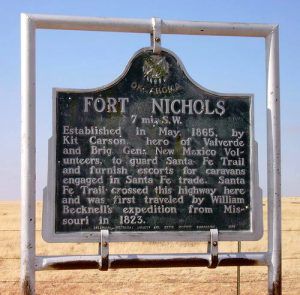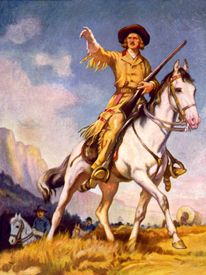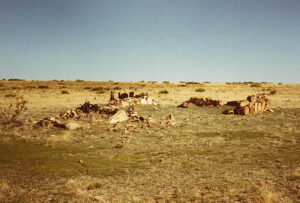Camp Nichols, Oklahoma, also known as Fort Nichols or Camp Nichols Ranch, was a historic fortification about 3.5 miles northwest of present-day Wheeless, Oklahoma.
In May 1865, General James H. Carleton, commander of the Department of New Mexico, ordered Colonel Christopher “Kit” Carson, the noted soldier, trapper, and scout, to establish a halfway post between Fort Dodge, Kansas, and Fort Union in New Mexico. Founded as the western terminus of the Aubry Route, this new post was intended to protect wagon trains traveling along the Cimarron and Aubry routes from Indian raids.
Situated on 40,000 square feet, the small fortified post was located on high ground between two forks of South Carrizozo Creek, about one-half mile north of the Santa Fe Trail and a short distance east of Cedar Spring. Thought to have been named in honor of Captain Charles P. Nichols of the First California Cavalry, it was enclosed by native stone walls built by soldiers around the parade ground.
It is thought that the fort was composed of approximately 25 buildings. These structures included various officer’s quarters, and barracks, though at first, soldiers lived in tents with stone walls, several guardhouses, and by far the most prominent building, the commissary. All buildings were fashioned of local materials, sandstone, adobe, and sod.
The post was constructed and manned by three companies of New Mexico and California volunteers who escorted wagon trains along the trail and protected traffic primarily from raids by Kiowa, Comanche, Cheyenne, and Arapaho Indians.
Lieutenant Richard Russell and his wife Marion arrived at the post in June 1865, about two weeks after construction began. Marion noted that the soldiers built several stone-walled dugouts with dirt floors and dirt roofs supported by logs. The stone walls of the dugouts formed an enclosure, outside of which was a moat. These structures housed the seven officers and had other functions, such as a hospital. Some 300 soldiers lived in tents and dugouts within the enclosure. There were also ten Indian scouts, two Indian women, and two laundresses who were wives of Hispanic soldiers at the post. Wagon trains outbound from New Mexico assembled at this post about 130 miles east of Fort Union. From here, they were escorted by detachments of troops to the Arkansas River.
Wagon trains stopped at Camp Nichols frequently. It never officially became a “fort” and was only utilized for a few short months.
Camp Nichols was only occupied for a few months before being abandoned in November 1865 by the Army when raids by Indians decreased.
It was the only military site on the trail in Oklahoma.
Today, nothing is left of the fort except a few tumbled stones. Though placed on the National Register of Historic Places in 1966, it is located on private property and is not accessible to the public. The ruins are situated on a high point of land between two ravines cut by the forks of South Carrizozo Creek. The topography is broken and wild, bestowing the site a scenic beauty accentuated by its isolation and freedom from modern intrusions.
Cedar Spring is one-quarter mile west of the ruins, in the shadow of cedar-covered bluffs. This was the water supply for the camp as well as for passing wagon trains. One-half mile south of the camp are exceptional remains of the Cimarron Cutoff. These may be followed for many miles. They vary from gullied ruts on steep slopes to shallow troughs 30 or 40 feet across and one or two feet deep. They execute sweeping curves around rough outcrops and descending and ascending stream course banks. Altogether they are among the most impressive trail remains along the entire trail.
© Kathy Alexander/Legends of America, updated April 2023.
Also See:
Sources:
Encyclopedia of Oklahoma
National Register Nomination
Wikipedia



